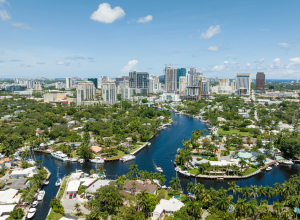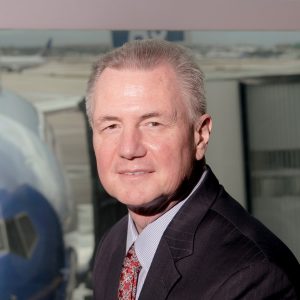Writer: Esteban Pages
 3 min read December 2023 — As 2023 draws to a close, the combined pressures of higher costs and the growing need for coastal resiliency could impact Broward’s sustainable growth.
3 min read December 2023 — As 2023 draws to a close, the combined pressures of higher costs and the growing need for coastal resiliency could impact Broward’s sustainable growth.
The persistent challenges of real estate-related inflation and the continued catalyst effect bringing in new residents and businesses into Broward poses a unique set of challenges. While population changes and an increase in business activity jolt economic growth, housing supply is struggling to keep up with the demand. In tandem, Florida accounted for three of AccuWeather’s top 10 most impactful weather events of 2023. Going forward, Broward stakeholders will need to be laser focused on infrastructure that can sustain sea level rise and other environmental concerns.
To understand the infrastructure needs in Broward, Invest: sat down with Michael Kroll, president and principal at Miller Legg Fort Lauderdale, Vincent Yarina, principal and vice president of Langan and Mark Gale, CEO of the Fort Lauderdale-Hollywood International Airport, to get their insights from their respective fields.
How would you characterize Broward’s priority infrastructure needs?
 Michael Kroll, President & Principal, Miller Legg Fort Lauderdale: Transportation and water resources are the two most critical things that need to be addressed. Coastal resiliency and sea level rise are also huge impacts on our communities. We live 13 miles from the coast and our home house is at an elevation above sea level, which is unheard of in most other areas of the country and demonstrates how susceptible all areas of South Florida are, not just the coastal areas. These issues present opportunities for our firm because we can solve those problems. So, we are at ground zero but it’s exactly where we need to be. Coastal cities are being proactive, so we are developing approaches for coastal resiliency improvements and hardening of waterfront properties. We must do that with minimal impacts to natural resources and need to go beyond sea walls and consider living shorelines to add biodiversity to our ecology rather than just sterilizing it for the sake of construction. That’s where we have to find a balance. Our firm really scrutinizes the environmental and ecological aspects to these engineering solutions.
Michael Kroll, President & Principal, Miller Legg Fort Lauderdale: Transportation and water resources are the two most critical things that need to be addressed. Coastal resiliency and sea level rise are also huge impacts on our communities. We live 13 miles from the coast and our home house is at an elevation above sea level, which is unheard of in most other areas of the country and demonstrates how susceptible all areas of South Florida are, not just the coastal areas. These issues present opportunities for our firm because we can solve those problems. So, we are at ground zero but it’s exactly where we need to be. Coastal cities are being proactive, so we are developing approaches for coastal resiliency improvements and hardening of waterfront properties. We must do that with minimal impacts to natural resources and need to go beyond sea walls and consider living shorelines to add biodiversity to our ecology rather than just sterilizing it for the sake of construction. That’s where we have to find a balance. Our firm really scrutinizes the environmental and ecological aspects to these engineering solutions.
 Vincent Yarina, Principal & Vice President, Langan: Affordable housing is a topic of significant importance, especially with the recent passage of the Live Local Act early in 2023. This legislation is poised to exert a substantial influence on our business and ongoing projects. It’s noteworthy that numerous affordable housing developers now have a compelling incentive to bring such vital housing options to the market. Another avenue with considerable potential lies within the infrastructure-related market. Notably, there are various opportunities in this domain, including expansions at the Fort Lauderdale Airport and crucial stormwater improvements throughout the county. These initiatives represent areas where we anticipate a significant amount of activity and potential growth. It’s worth noting that while we may not observe the same volume of industrial development work as in previous years, it appears to have reached a point of stability.
Vincent Yarina, Principal & Vice President, Langan: Affordable housing is a topic of significant importance, especially with the recent passage of the Live Local Act early in 2023. This legislation is poised to exert a substantial influence on our business and ongoing projects. It’s noteworthy that numerous affordable housing developers now have a compelling incentive to bring such vital housing options to the market. Another avenue with considerable potential lies within the infrastructure-related market. Notably, there are various opportunities in this domain, including expansions at the Fort Lauderdale Airport and crucial stormwater improvements throughout the county. These initiatives represent areas where we anticipate a significant amount of activity and potential growth. It’s worth noting that while we may not observe the same volume of industrial development work as in previous years, it appears to have reached a point of stability.

Mark Gale, CEO, Fort Lauderdale-Hollywood International Airport: The exponential growth FLL experienced over the last decade triggered a comprehensive evaluation of our facilities, particularly given our bustling international traffic. Terminal expansion projects were already underway, yet it became clear that we’d quickly run out of space given the already congested roadways and our relatively smaller terminal footprints. The focus was thus shifted to match the airport’s capabilities with the ambitions of air carriers like JetBlue, Spirit, and Southwest, which sought to tap into the South Florida market. Phase 1 of the master plan includes new parking facilities, an Automated People Mover (APM), Intermodal Center (IMC), a commercial center and additional terminal expansion. These investments are crucial to ensure seamless connectivity and accommodate future growth.
What is your outlook for Broward County?
Kroll: I am a member of a national group of CEOs, and recruiting is always the No. 1 talking point. The challenges in South Florida start with the fact that it’s not an inexpensive place to live, and that is especially challenging for people in the entry-level stage of their careers. The need for workforce housing that is affordable for these early career professionals is critical. Also, there isn’t a significant public transit network, so we live in a car-centric community.
Artificial intelligence is also an interesting issue right now. While we know it will help us in the future, it raises complex questions regarding cybersecurity. We have to make sure the assets and resources at the firm aren’t compromised. AI is doing more harvesting than production right now. It is something we need to be on top of in order to avoid severe security complications.
Yarina: The outlook for Broward County and the state of Florida as a whole is undoubtedly positive. This region continues to attract demographic changes, with people moving here, driving development opportunities. However, I also want to emphasize the ongoing challenge in our industry regarding a significant shortage of skilled and qualified professionals. This shortage extends to various technical roles in construction and engineering. Finding the right people with the necessary qualifications and expertise remains a substantial hurdle for us. We hope that with changing demographics and a potential influx of talent from other areas, we’ll be able to address this issue more effectively.
Gale: Our airport’s outlook remains positive, regardless of the potential merger of JetBlue and Spirit. We’re witnessing a strong resurgence in traffic, accompanied by shifts in airline behavior and strategy. While the number of takeoffs and landings might not increase at the same rate, it will increase. Additionally, airlines are either adding more seats to existing planes or opting for larger aircraft, with approximately 12% more seat capacity on average, a reflection of robust demand for activity at FLL and Broward County. There’s an emphasis on improving vehicular navigation around the airport in the short and long term. One short-term project involves a series of exit roadway modifications aimed at reducing traffic along the airport’s main Terminal Drive, installation of new traffic control devices, and a new Bus Slip ramp for authorized vehicles. Separately, we’re currently preparing to put a bid out for connecting Terminal 1 to Terminal 2 and Terminal 2 to Terminal 3, both behind security. This project is slated to be finished by 2026-2027, aligning with Terminal 5’s completion.
Top image via Sublime Imagery; Fort Lauderdale DDA
For more information, please visit:

